|
|
Cycling Spiti and Lahaul:
Translated by PROMT-Online-Translator
| Country: |
India |
Tour: |
Spiti and Lahaul Täler |
| Start: |
Manali |
End: |
Shimla |
| Route: |
Manali, Marhi, Rothang Pass, Kunzum La, Kaza, Kaza,
Tabo, Rekong Peo, Rampur, Shimla |
| Distance: |
|
Time: |
2 weeks |
| Support: |
some small places |
Ascent in metersr: |
|
| Difficulties: |
|
| Rating: |
Superbeautyful tour, even if the mountains are not so
nice as at the Manali - Leh tour but the more friendlier arethe people.
Also joins with the Manali - Leh travel |
| |
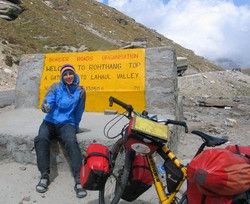 Then from Manali it went again in the direction
of red slope passport (for Nadine to the 1st time and for me already
to the 4th time (2x bike and 2x coach)). As already with my first
Bikeüberquerung we also mastered on the first day the 38-km-long
distance with a rise of 1400 metres height to briefly behind Marhi.
After a not too restful night (our tent was on the brink about 5 m
beside the street and every going past car illuminated us) we scaled
in the next morning the last metres height to the 3979-m-high red
slope passport. As well as this time the first time it was also cold
and windy and we were to be able to warm up gladly to us briefly below
the passport crossing in one of many small Dhabas (Zeltstraßenrestaurant)
with a cup of hot tea. After a short photo and "Warmanzieh"
traces then it went on the other side in many turning down in the
Lahaul valley. Then from Manali it went again in the direction
of red slope passport (for Nadine to the 1st time and for me already
to the 4th time (2x bike and 2x coach)). As already with my first
Bikeüberquerung we also mastered on the first day the 38-km-long
distance with a rise of 1400 metres height to briefly behind Marhi.
After a not too restful night (our tent was on the brink about 5 m
beside the street and every going past car illuminated us) we scaled
in the next morning the last metres height to the 3979-m-high red
slope passport. As well as this time the first time it was also cold
and windy and we were to be able to warm up gladly to us briefly below
the passport crossing in one of many small Dhabas (Zeltstraßenrestaurant)
with a cup of hot tea. After a short photo and "Warmanzieh"
traces then it went on the other side in many turning down in the
Lahaul valley. |
| |
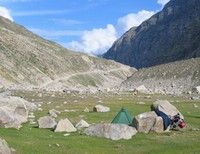 Though we already are on the move for a while, however, seldom
we had a so fantastically nice overnight stay place like here shortly
before Chhatru in the Lahaul valley. Wonderful meadow, a unique view
and fresh source water only 100 m away from the tent. What does one
want more? Though we already are on the move for a while, however, seldom
we had a so fantastically nice overnight stay place like here shortly
before Chhatru in the Lahaul valley. Wonderful meadow, a unique view
and fresh source water only 100 m away from the tent. What does one
want more? |
| |
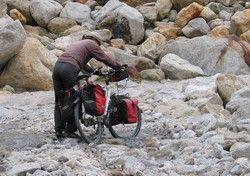 Actually, we hoped for a loose day, nevertheless,
stood only 34 km, to a river uphill after, on a program. The fact
that we had to count on grit runway was already clear to us, however
that our driving layer became even so bad at a place that we not even
could go any more we not thought. In particular between Chatru and
Chotta Dhara we hard had to fight, because here very often the street
was built just from round river pebbles (coarse cobblestones are a
dream against it). We had to fight from Chotta Dhara to all abundance
still with rain. The only one to us on this day for the help came
was, actually, quite unusual, the wind which pushed us kindly a little
bit from the back. Then with the adverse conditions we were also exhausted
quite when we in the evening, after a total of 5.5 hours for 37 km
(it were 3 more than according to map) Batal reached. Actually, we hoped for a loose day, nevertheless,
stood only 34 km, to a river uphill after, on a program. The fact
that we had to count on grit runway was already clear to us, however
that our driving layer became even so bad at a place that we not even
could go any more we not thought. In particular between Chatru and
Chotta Dhara we hard had to fight, because here very often the street
was built just from round river pebbles (coarse cobblestones are a
dream against it). We had to fight from Chotta Dhara to all abundance
still with rain. The only one to us on this day for the help came
was, actually, quite unusual, the wind which pushed us kindly a little
bit from the back. Then with the adverse conditions we were also exhausted
quite when we in the evening, after a total of 5.5 hours for 37 km
(it were 3 more than according to map) Batal reached. |
| |
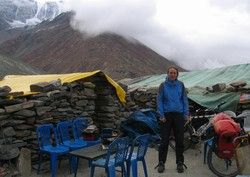 Everywhere round us lay only coarse river gravel and thus
it would be to be built up become rather difficult our tent. We were
accordingly glad that we might spend the night in a small stone hut
beside the Dhaba. Though it was also relatively drafty in the stone
hut, we had a plastic tarpaulin as a roof and Türe, and the wind
whistled by the scratches, however, resist it was fairly comfortable. Everywhere round us lay only coarse river gravel and thus
it would be to be built up become rather difficult our tent. We were
accordingly glad that we might spend the night in a small stone hut
beside the Dhaba. Though it was also relatively drafty in the stone
hut, we had a plastic tarpaulin as a roof and Türe, and the wind
whistled by the scratches, however, resist it was fairly comfortable.
|
| |
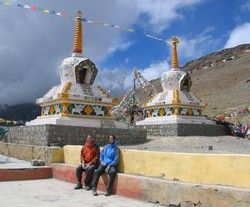 Also the distance between Batal and the Kunzum La was only
gravelled of course. On the last pair of kilometres before the passport
Nadine gave a hard time beside the bad and partly precipitous distance
in particular the meanwhile nevertheless rather thin height air. Because
she wanted to see, however, absolutely also some of the high mountains
it courageously struggled, now and again also pushing, the last metres
up to the Kunzum La situated on 4551 m (La passport) is called high.
Here, unfortunately, we have found no nice sign before which we could
allow to take a photo of ourselves on this really hard compiled passport
crossing and made do thus with the Chörten. Also the distance between Batal and the Kunzum La was only
gravelled of course. On the last pair of kilometres before the passport
Nadine gave a hard time beside the bad and partly precipitous distance
in particular the meanwhile nevertheless rather thin height air. Because
she wanted to see, however, absolutely also some of the high mountains
it courageously struggled, now and again also pushing, the last metres
up to the Kunzum La situated on 4551 m (La passport) is called high.
Here, unfortunately, we have found no nice sign before which we could
allow to take a photo of ourselves on this really hard compiled passport
crossing and made do thus with the Chörten. |
| |
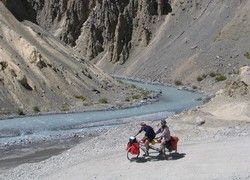 On the day after the Überquerung of the Kunzum
La we hit on John and Anne, an older married couple from New Zealand
which wanted to explore the mountains of Northern India with her tandem.
They came back just from Leh in Ladakh and were, like us, on the way
to Shimla. We got on right away very well, however, her well-intentioned
request, we would not need on them wait, and, nevertheless, should
already go on quietly, never clapped so properly. We were because
as quick, or better was more difficult said as slowly as the both,
so that we cycled the day together (what not only was due that Martin's
bike than her tandem). In the afternoon we wanted to visit, actually,
only briefly a convent nevertheless before we we provided we were
led by the only man of the cloister, a monk and teacher in whom kitchen
and there were spoilt by the nuns on most delightful with tea and
home-made savory snacks. However, after the small afternoon tea we
received a small guided tour by the cloister where we might attend
beside a comfortably furnished cubicle of the nuns (with own small
stove for the cold winter months), also the classroom of the small
convent school. Then in the evening we reached together Kaza. Kaza
is the "capital" of Spiti and the place in we had to apply
for our licence for the continuation of the journey to Kinnaur and
Shimla. The street of Kaza to Shimla advances very near to Chinese
/ Tibetan border (to 10 km), so that one needs for this an easily
too preserved special licence. After we, together with John and Anne,
our licence had received (after about 3.5 hrs), we went in the evening
still by the coach in the Kibber situated on 4205 m which is called
even the highest mountain village of the world (although the neighbouring
place lies 50 m higher!!!). On the day after the Überquerung of the Kunzum
La we hit on John and Anne, an older married couple from New Zealand
which wanted to explore the mountains of Northern India with her tandem.
They came back just from Leh in Ladakh and were, like us, on the way
to Shimla. We got on right away very well, however, her well-intentioned
request, we would not need on them wait, and, nevertheless, should
already go on quietly, never clapped so properly. We were because
as quick, or better was more difficult said as slowly as the both,
so that we cycled the day together (what not only was due that Martin's
bike than her tandem). In the afternoon we wanted to visit, actually,
only briefly a convent nevertheless before we we provided we were
led by the only man of the cloister, a monk and teacher in whom kitchen
and there were spoilt by the nuns on most delightful with tea and
home-made savory snacks. However, after the small afternoon tea we
received a small guided tour by the cloister where we might attend
beside a comfortably furnished cubicle of the nuns (with own small
stove for the cold winter months), also the classroom of the small
convent school. Then in the evening we reached together Kaza. Kaza
is the "capital" of Spiti and the place in we had to apply
for our licence for the continuation of the journey to Kinnaur and
Shimla. The street of Kaza to Shimla advances very near to Chinese
/ Tibetan border (to 10 km), so that one needs for this an easily
too preserved special licence. After we, together with John and Anne,
our licence had received (after about 3.5 hrs), we went in the evening
still by the coach in the Kibber situated on 4205 m which is called
even the highest mountain village of the world (although the neighbouring
place lies 50 m higher!!!). |
| |
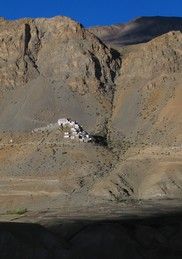 Already in the preeve, shortly before our arrival in Kaza,
we could admire the impressive situation of the Gompa of Ki, from
the other river side. Now, 2 days later, on our way back of Kibber,
we paid of the Gompa a visit. Already shortly before the Gompa we
hit on the young monks who sold the Sunday morning with Cricket to
themselves. Then in the cloister inner courtyard we hit instead of
on monks on a few older locals. Almost we would have gone again, one
of the locals who turned happily twaddling his prayer mill not would
not have encouraged us to go by a small Türe further to the inside
of the cloister. Hesitantly we followed his council, are entitled
only a few metres farther before a Türe on which stood that the
admission is permitted only to monks. The next Türe it was half-open
and when we had an eye carefully in the room lying behind it (kitchen),
we were already asked by a young monk. Alswäre it the same-most
understandable of the world he cooked unserst once a cup of tea. To
the tea we again received Tsampa, the main food of the Ladakhis, passed.
Tsampa exists basically of roasted barley flour, with some butter
and presumably some sugar (whether sugar ordinarily belonged to it
we do not know, however, with us he was present at least) is fortified.
Afterwards we received a small private guided tour by the Gompa. The
young monk opened for us all close rooms and after he to us the last
room, the prayer hall, had pointed, he had disappeared so fast as
he had appeared before. We not even had to thank time him properly.
Again in the inner courtyard opened us then older not to say old monk,
the room with the big prayer mill. After we the a little bit shyly
room to examined ones he requested us, the prayer mill, nevertheless,
sometimes hard anzuschupsen. The whole case, however, apparently was
not completely geheuer to him, because all along he stopped in the
Türe and murmured his "O Mani Padme Hum". Already in the preeve, shortly before our arrival in Kaza,
we could admire the impressive situation of the Gompa of Ki, from
the other river side. Now, 2 days later, on our way back of Kibber,
we paid of the Gompa a visit. Already shortly before the Gompa we
hit on the young monks who sold the Sunday morning with Cricket to
themselves. Then in the cloister inner courtyard we hit instead of
on monks on a few older locals. Almost we would have gone again, one
of the locals who turned happily twaddling his prayer mill not would
not have encouraged us to go by a small Türe further to the inside
of the cloister. Hesitantly we followed his council, are entitled
only a few metres farther before a Türe on which stood that the
admission is permitted only to monks. The next Türe it was half-open
and when we had an eye carefully in the room lying behind it (kitchen),
we were already asked by a young monk. Alswäre it the same-most
understandable of the world he cooked unserst once a cup of tea. To
the tea we again received Tsampa, the main food of the Ladakhis, passed.
Tsampa exists basically of roasted barley flour, with some butter
and presumably some sugar (whether sugar ordinarily belonged to it
we do not know, however, with us he was present at least) is fortified.
Afterwards we received a small private guided tour by the Gompa. The
young monk opened for us all close rooms and after he to us the last
room, the prayer hall, had pointed, he had disappeared so fast as
he had appeared before. We not even had to thank time him properly.
Again in the inner courtyard opened us then older not to say old monk,
the room with the big prayer mill. After we the a little bit shyly
room to examined ones he requested us, the prayer mill, nevertheless,
sometimes hard anzuschupsen. The whole case, however, apparently was
not completely geheuer to him, because all along he stopped in the
Türe and murmured his "O Mani Padme Hum". |
| |
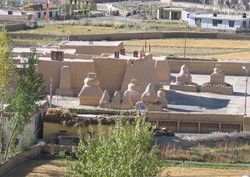 Tabo Gompa: A day stage away from Kaza there lies
Tabo. The Gompa of Tabo is one of the most important cloisters the
Tibetan Buddhism and was built more than 1000 years ago. Besides,
is planned that retired the Dalai Lama IVX here becomes (thought,
actually, that the Dalai Lama on lifetime the worldly and religious
head of the Tibetans is and only the death releases him from his assignments).
The unusual situation of the cloister is remarkable first first of
all. While all Gompas which we have seen up to now either on mountain
hilltops or in precipitous mountain slopes were positioned lay the
Tabo Gompa in the middle of the valley. It is interesting also that
the whole whole cloister complex was invested here at ground level,
and not multistoried as usual commonly. Furthermore he orders the
Tabo Gompa of some Best, to preserved examples of the Indo-Tibetan
art, which is why this take photos in the different temples was not
forbidden to damage (around the paints of the painted walls). Tabo Gompa: A day stage away from Kaza there lies
Tabo. The Gompa of Tabo is one of the most important cloisters the
Tibetan Buddhism and was built more than 1000 years ago. Besides,
is planned that retired the Dalai Lama IVX here becomes (thought,
actually, that the Dalai Lama on lifetime the worldly and religious
head of the Tibetans is and only the death releases him from his assignments).
The unusual situation of the cloister is remarkable first first of
all. While all Gompas which we have seen up to now either on mountain
hilltops or in precipitous mountain slopes were positioned lay the
Tabo Gompa in the middle of the valley. It is interesting also that
the whole whole cloister complex was invested here at ground level,
and not multistoried as usual commonly. Furthermore he orders the
Tabo Gompa of some Best, to preserved examples of the Indo-Tibetan
art, which is why this take photos in the different temples was not
forbidden to damage (around the paints of the painted walls). |
| |
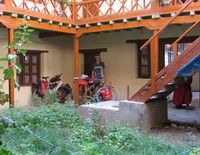 Puja in the Tabo Gompa: After we had spent
now already a night in a church and in a mosque now we decided to
spend the night in the guesthouse belonging to the cloister. After
one, at least for me, too short night the alarm clock already rang
shortly after 5 o'clock in the morning again. We wanted to take part
in all morgentlichen Puja (prayer ceremony). Shortly before 6 o'clock
we stood freshly washed before the prayer hall, nevertheless, neither
from the monks nor from the other tourists something was to be seen
far and wide. After one stays then the first came, still richly sleep
away active monk, opened the prayer room and disappeared in it. After
another two other monks and a tourist had disappeared in the prayer
room we also went in only to find out that the Puja were already in
full walk (with only 3 monks). Now bit by bit the remaining cloister
members also spun equipped with an empty teacup one, established themselves
on her hereditary places and many in the speech song of the others
with one. After just 20 minutes, the last monks had arrived scarcely,
then there was a round tea for everybody (also for us tourists) and
two young novices even a few biscuits nibbled. While the tourists
sat predominantly very much tensely on her places (consciously calmly
and concentrates active) the monks took the Morgenpuja rather a little
more laxly. After just 1 half an hour, I had not drunk up yet my tea,
was over the Puja all at once. Ordinarily there lasts the Puja about
1 hour, however because for the today the Prime Minister of Himachal
Pradesch (an Indian federal state) had announced himself for visit,
still some preparations had to be made of course. Now it became also
clear to us, why we had seen on the way from Kaza to Tabo so many
street workers who turned the street and repaired, nevertheless, the
Prime Minister on this distance segment should travel instead of with
his helicopter with the jeep. For a day wage from converted about
1.1€ turned the women the street during the office workers of
the road construction company for about 3€ per day worked. To
us the whole bustle was a little bit too much and thus we already
made a getaway before arrival of the high guest. Puja in the Tabo Gompa: After we had spent
now already a night in a church and in a mosque now we decided to
spend the night in the guesthouse belonging to the cloister. After
one, at least for me, too short night the alarm clock already rang
shortly after 5 o'clock in the morning again. We wanted to take part
in all morgentlichen Puja (prayer ceremony). Shortly before 6 o'clock
we stood freshly washed before the prayer hall, nevertheless, neither
from the monks nor from the other tourists something was to be seen
far and wide. After one stays then the first came, still richly sleep
away active monk, opened the prayer room and disappeared in it. After
another two other monks and a tourist had disappeared in the prayer
room we also went in only to find out that the Puja were already in
full walk (with only 3 monks). Now bit by bit the remaining cloister
members also spun equipped with an empty teacup one, established themselves
on her hereditary places and many in the speech song of the others
with one. After just 20 minutes, the last monks had arrived scarcely,
then there was a round tea for everybody (also for us tourists) and
two young novices even a few biscuits nibbled. While the tourists
sat predominantly very much tensely on her places (consciously calmly
and concentrates active) the monks took the Morgenpuja rather a little
more laxly. After just 1 half an hour, I had not drunk up yet my tea,
was over the Puja all at once. Ordinarily there lasts the Puja about
1 hour, however because for the today the Prime Minister of Himachal
Pradesch (an Indian federal state) had announced himself for visit,
still some preparations had to be made of course. Now it became also
clear to us, why we had seen on the way from Kaza to Tabo so many
street workers who turned the street and repaired, nevertheless, the
Prime Minister on this distance segment should travel instead of with
his helicopter with the jeep. For a day wage from converted about
1.1€ turned the women the street during the office workers of
the road construction company for about 3€ per day worked. To
us the whole bustle was a little bit too much and thus we already
made a getaway before arrival of the high guest. |
| |
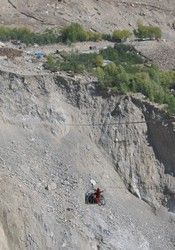 Landslide at Milling: With Milling, on half a way
between Tabo and Rekon Peo, there lay a place infamous her for many
years for landslides. Nevertheless, the last landslide was so violent
that, besides, half a mountain with has slipped off and made thus
a repair of the street impossibly. So one decided to build a new street
(it is mainly already finished) and to bridge the landslide place
with two material cable railway in the interim. If a coach on one
side of the cable railway comes now all passengers get out and send
her luggage with the cable railway on the other side. Because the
cable railway must transport no people one him the landslide place
handle what means a descent in the valley and reclimb of 250 metres
height. When we at aforesaid place arrived one of both material cable
railway Kaput had gone just shortly before and therefore had frequented
the other cable railway very strongly. The winter approached and thus
wood and straw had to be transported massively for the military and
civilian population in the remote mountain region. With the being
absent competition the price of the luggage promotion also doubled
of course, however, umtragen of the equipment would have been extremely
strenuous (we would presumably have needed a whole day). After our
bicycles and our luggage were already on the other side of the landslide,
we got on the way, and after about 1.5 hours we had also overcome
the landslide place. Landslide at Milling: With Milling, on half a way
between Tabo and Rekon Peo, there lay a place infamous her for many
years for landslides. Nevertheless, the last landslide was so violent
that, besides, half a mountain with has slipped off and made thus
a repair of the street impossibly. So one decided to build a new street
(it is mainly already finished) and to bridge the landslide place
with two material cable railway in the interim. If a coach on one
side of the cable railway comes now all passengers get out and send
her luggage with the cable railway on the other side. Because the
cable railway must transport no people one him the landslide place
handle what means a descent in the valley and reclimb of 250 metres
height. When we at aforesaid place arrived one of both material cable
railway Kaput had gone just shortly before and therefore had frequented
the other cable railway very strongly. The winter approached and thus
wood and straw had to be transported massively for the military and
civilian population in the remote mountain region. With the being
absent competition the price of the luggage promotion also doubled
of course, however, umtragen of the equipment would have been extremely
strenuous (we would presumably have needed a whole day). After our
bicycles and our luggage were already on the other side of the landslide,
we got on the way, and after about 1.5 hours we had also overcome
the landslide place. |
| |
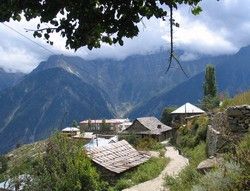 Apple theft in Kalpa: Meanwhile
we are very glad that we with a guide are on the move. Just if one
by the bicycle is on the move it can happen very easily that one cycles
only few kilometres along especially worth seeing places. Without
our guide we would never have found out absolutely also from Kalpa,
the nice small mountain village 10 km above Rekong Peo (the Verwaltugszentrum
of Kinnaur). There to master about 600 metres height on the 10-km-long
distance, however were we decided to take the coach. Kalpa, although
once capital of Kinnaur, is rather a small village the place in should
be the Hindu divinity Shiva in winter moves back. The place through
his winding lanes, the roofs covered with stone disks and many apple
trees is especially attractive. Presumably just because there were
several all over full apple trees in every garden, even an apple was
to be found in no shop in completely Kalpa. Nadine small a little
after apples is addicted, therefore, could not resist the temptation
and swiped to themselves from one of the trees standing in the wayside
simply 2 apples. Apple theft in Kalpa: Meanwhile
we are very glad that we with a guide are on the move. Just if one
by the bicycle is on the move it can happen very easily that one cycles
only few kilometres along especially worth seeing places. Without
our guide we would never have found out absolutely also from Kalpa,
the nice small mountain village 10 km above Rekong Peo (the Verwaltugszentrum
of Kinnaur). There to master about 600 metres height on the 10-km-long
distance, however were we decided to take the coach. Kalpa, although
once capital of Kinnaur, is rather a small village the place in should
be the Hindu divinity Shiva in winter moves back. The place through
his winding lanes, the roofs covered with stone disks and many apple
trees is especially attractive. Presumably just because there were
several all over full apple trees in every garden, even an apple was
to be found in no shop in completely Kalpa. Nadine small a little
after apples is addicted, therefore, could not resist the temptation
and swiped to themselves from one of the trees standing in the wayside
simply 2 apples. |
| |
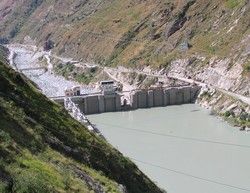 The disappeared river: Already
since Kaza our street followed only the river Spiti, and afterwards
to the Sutlej coming from Tibet / China into which the Spiti flows
near the border. All along we had a miraculous view at the nice imposing
mountain river which is absolutely a dream for Wildwasserkanuten.
First we were surprised a little bit when the river was stopped all
at once with a reservoir. Nevertheless, something were confused we
when on the other side of the traffic jam wall any more a small rivlet
was not even to be seen. Just in the mountains of India there are
a lot of hydroelectric power plants. Here apparently one had diverted
for the optimisation of the energy efficiency a whole river underground,
because in Rapur (several kilometres later) it rushed of the Sutlej,
even if very brown and slushy, again with his original strength by
the valley. The disappeared river: Already
since Kaza our street followed only the river Spiti, and afterwards
to the Sutlej coming from Tibet / China into which the Spiti flows
near the border. All along we had a miraculous view at the nice imposing
mountain river which is absolutely a dream for Wildwasserkanuten.
First we were surprised a little bit when the river was stopped all
at once with a reservoir. Nevertheless, something were confused we
when on the other side of the traffic jam wall any more a small rivlet
was not even to be seen. Just in the mountains of India there are
a lot of hydroelectric power plants. Here apparently one had diverted
for the optimisation of the energy efficiency a whole river underground,
because in Rapur (several kilometres later) it rushed of the Sutlej,
even if very brown and slushy, again with his original strength by
the valley. |
| |
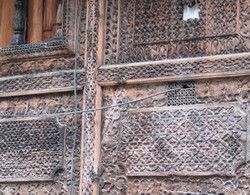 Wooden house in Rampur: Rampur is an old
place and lay on Seidenstrasse to China. Still today the splendid
carvings testify in the old houses in the bazaar of the former wealth
of the town. Wooden house in Rampur: Rampur is an old
place and lay on Seidenstrasse to China. Still today the splendid
carvings testify in the old houses in the bazaar of the former wealth
of the town. |
| |
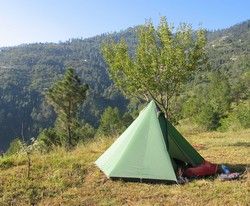 Rampur - Shimla: Although in the middle
of the mountains Rampur lies only on a height of about 900 M.ü.
M. Nevertheless, on our way to Shimla (2200m) our street led what
to us again a small laborious mountain drive about Narkanda (2700m)
gave. Differently than on our way from Kaza to Rampur which we had
to follow, actually, only one river to valley and, besides , daily
at least 500 metres height uphill had to cycle!!!, it should go from
Narkanda to Shimla along from mountain crests. To believe hardly,
however, on the 70-km-long stage the street ran almost predominantly
level or downhill with only few small counterincreases! Rampur - Shimla: Although in the middle
of the mountains Rampur lies only on a height of about 900 M.ü.
M. Nevertheless, on our way to Shimla (2200m) our street led what
to us again a small laborious mountain drive about Narkanda (2700m)
gave. Differently than on our way from Kaza to Rampur which we had
to follow, actually, only one river to valley and, besides , daily
at least 500 metres height uphill had to cycle!!!, it should go from
Narkanda to Shimla along from mountain crests. To believe hardly,
however, on the 70-km-long stage the street ran almost predominantly
level or downhill with only few small counterincreases! |
| |
|
|
I
BOOKLET
available
for
DONATION!

50pages, 80 b/w photos, background
infos, stories, ...
Just send your donation
to our
Pay
Pal account: nadinepuschkasch@yahoo.de
and email us your post
address and we´ll send it to you.
|
| |
| |
|
Like to place your Ad here?
Just e-mail to:
martinlunz@yahoo.de
|
| |
| |
|
You
liked our website and like to contribute?
Our Pay
Pal account is: nadinepuschkasch@yahoo.de
|
|
| |
|
